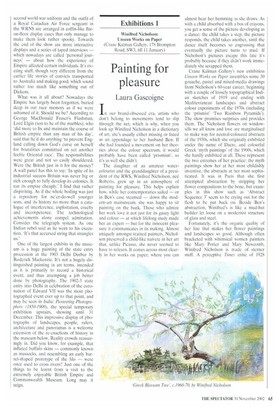Winifred Nicholson: - Unseen Works on Paper (Crane Kalman Gallery, 178 Brompton Road, SW3, till 11 January)
Painting for pleasure
Laura Gascoigne
In our brand-obsessed era, artists who don't belong to movements tend to slip through the net, which is why, when you look up Winifred Nicholson in a dictionary of art, she's usually either missing or listed as an appendage to her husband Ben. If she had founded a movement on her theories about the colour spectrum, it would probably have been called 'prismism', so it's as well she didn't.
The daughter of an amateur watercolourist and the granddaughter of a president of the RWS, Winifred Nicholson, nee Roberts, grew up in an atmosphere of painting for pleasure. This helps explain how, while her contemporaries sailed — or in Ben's case steamed — down the modern-art mainstream, she was happy to sit painting on the bank. Those who admire her work love it not just for its gauzy light and colour — at which lifelong study made her an expert — but for the innocent pleasure it communicates in its making. Almost uniquely amongst trained painters, Nicholson preserved a child-like naivete in her art that, unlike Picasso, she never seemed to have to relearn. It comes across most clearly in her works on paper, where you can
almost hear her humming as she draws. As with a child absorbed with a box of crayons, you get a sense of the picture developing as a dance: the child takes a step, the picture responds, the child takes another, until the dance itself becomes so engrossing that eventually the picture turns to mud, If Nicholson's pictures escape this fate it's probably because if they didn't work immediately she scrapped them.
Crane Kalman Gallery's new exhibition Unseen Works on Paper assembles some 30 gouache, pastel and mixed-media drawings from Nicholson's 60-year career, beginning with a couple of loosely topographical Indian sketches of 1919 and ending with Mediterranean landscapes and abstract colour experiments of the 1970s (including the `prismist"Two Rainbow Pyramids). The show promises surprises and provides them. The Nicholson flowers on windowsills we all know and love are marginalised to make way for neutral-coloured abstracts of the 1930s, which she originally exhibited under the name of Dacre, and colourful Greek `myth paintings' of the 1960s, which she hardly exhibited at all. These represent the two extremes of her practice: the myth paintings show her at her most childishly inventive, the abstracts at her most sophisticated. It was in Paris that she first attempted abstraction by stripping her flower compositions to the bone, but examples in this show such as 'Abstract Sequence 3' seem to be crying out for the flesh to be put back on. Beside Ben's abstraction, Winifred's is like a mud-hut builder let loose on a modernist structure of glass and steel, Fortunately, it's the organic quality of her line that makes her flower paintings and landscapes so good. Although often bracketed with whimsical women painters like Mary Potter and Mary Newcomb, Winifred Nicholson is made of sterner stuff. A perceptive Times critic of 1928 identified her genius as her ability to see flowers 'as emanations of earth', and even her airiest paintings are rooted in reality by sturdy drawing and sudden depths of tone. There's no misty-eyed whimsy in Nicholson's view of nature: her hills aren't rolling, they're lumpy; her trees aren't spreading, they're clumpy; and her flowers aren't slender, they're stumpy. Her beautiful light may conjure a Christian Scientist vision of heaven, but her artistic vision is umbilically tied to earth. However great her professed admiration for Mondrian's 'precise correctness which is like mathematics, more of Truth than nature could ever oblige one to follow', her own grasp of abstraction didn't stretch beyond mental arithmetic — in the realm of pure maths, she's at sixes and sevens. Her unseen abstracts are an interesting diversion, but the landscape and flower paintings in this exhibition made me glad she didn't stray from the path of nature for long.



























































































 Previous page
Previous page